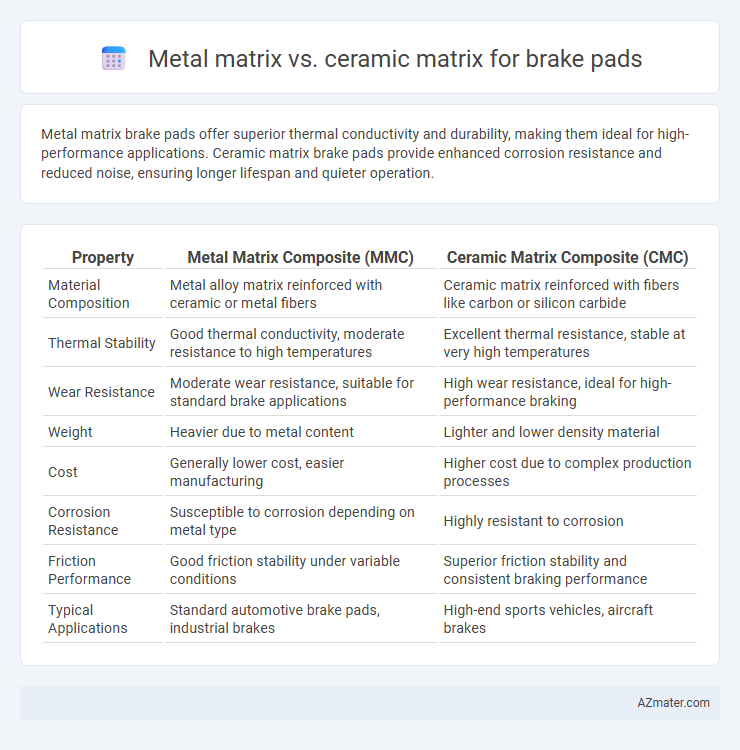Metal matrix brake pads offer superior thermal conductivity and durability, making them ideal for high-performance applications. Ceramic matrix brake pads provide enhanced corrosion resistance and reduced noise, ensuring longer lifespan and quieter operation.
Table of Comparison
| Property | Metal Matrix Composite (MMC) | Ceramic Matrix Composite (CMC) |
|---|---|---|
| Material Composition | Metal alloy matrix reinforced with ceramic or metal fibers | Ceramic matrix reinforced with fibers like carbon or silicon carbide |
| Thermal Stability | Good thermal conductivity, moderate resistance to high temperatures | Excellent thermal resistance, stable at very high temperatures |
| Wear Resistance | Moderate wear resistance, suitable for standard brake applications | High wear resistance, ideal for high-performance braking |
| Weight | Heavier due to metal content | Lighter and lower density material |
| Cost | Generally lower cost, easier manufacturing | Higher cost due to complex production processes |
| Corrosion Resistance | Susceptible to corrosion depending on metal type | Highly resistant to corrosion |
| Friction Performance | Good friction stability under variable conditions | Superior friction stability and consistent braking performance |
| Typical Applications | Standard automotive brake pads, industrial brakes | High-end sports vehicles, aircraft brakes |
Introduction to Brake Pad Materials
Brake pads utilize metal matrix composites (MMC) and ceramic matrix composites (CMC) to balance performance and durability in braking systems. Metal matrix brake pads offer high thermal conductivity and excellent wear resistance, suitable for high-stress environments like racing vehicles. Ceramic matrix brake pads provide quieter operation, lower dust production, and enhanced thermal stability, making them ideal for everyday passenger cars and light trucks.
What are Metal Matrix Brake Pads?
Metal matrix brake pads consist of a composite material where metal particles such as copper, steel, or iron are embedded within a binder matrix to enhance durability and heat dissipation. These brake pads provide superior performance in high-temperature environments due to their excellent thermal conductivity and strength. Metal matrix brake pads are commonly used in heavy-duty vehicles and high-performance applications where enhanced braking power and longevity are critical.
What are Ceramic Matrix Brake Pads?
Ceramic matrix brake pads consist of ceramic fibers embedded within a matrix designed to withstand extreme heat and reduce wear on braking systems. These pads offer superior durability, quieter operation, and produce less brake dust compared to traditional metallic options. Their stable chemical properties provide consistent braking performance under diverse driving conditions and prolonged use.
Composition and Structure Comparison
Metal matrix brake pads typically consist of steel fibers, iron, and other metallic particles embedded within a resin binder, providing high thermal conductivity and mechanical strength. Ceramic matrix brake pads are primarily composed of ceramic fibers such as alumina or silica, combined with non-metallic fillers and bonding agents that offer enhanced heat resistance and reduced wear. The microstructure of metal matrix pads features a dense, metallic network ideal for high-temperature performance, while ceramic matrix pads exhibit a porous, rigid framework designed for thermal stability and quieter operation.
Performance Differences: Metal Matrix vs Ceramic Matrix
Metal matrix brake pads offer superior heat dissipation and toughness, resulting in better performance under high-stress conditions such as heavy braking or racing. Ceramic matrix brake pads excel in producing less brake dust and delivering quieter operation, enhancing longevity and user comfort. While metal matrix pads provide stronger friction and durability, ceramic matrix options prioritize consistent performance with minimal wear and reduced rotor damage.
Wear and Longevity Analysis
Metal matrix brake pads exhibit superior wear resistance due to their high thermal conductivity and toughness, effectively dissipating heat and reducing abrasion during braking cycles. Ceramic matrix brake pads offer enhanced longevity with stable friction characteristics and minimal wear debris, contributing to cleaner operation and extended lifespan under moderate driving conditions. Comparative wear analysis indicates metal matrix compositions excel in heavy-duty applications, while ceramic matrices provide optimal durability in daily commuting scenarios requiring consistent performance.
Heat Dissipation and Thermal Management
Metal matrix brake pads exhibit superior heat dissipation due to the high thermal conductivity of metals like copper and steel, enabling efficient thermal management during heavy braking. Ceramic matrix brake pads, while offering lower thermal conductivity, provide more stable temperatures and reduce heat fade due to their heat-resistant ceramic fibers and fillers. Effective thermal management in brake pads depends on balancing rapid heat dissipation in metal matrices with the heat stability and fade resistance characteristic of ceramic matrices.
Noise and Dust Generation
Metal matrix brake pads typically generate higher noise levels due to increased friction and metal-to-metal contact, while ceramic matrix brake pads produce quieter braking with minimal noise. Ceramic matrices also create significantly less brake dust, offering cleaner wheels and reduced airborne particulates compared to metal matrix composites. This makes ceramic matrix pads advantageous for drivers prioritizing low noise and dust reduction in braking performance.
Cost and Value Considerations
Metal matrix brake pads generally offer a lower upfront cost compared to ceramic matrix pads, making them a budget-friendly option for standard braking needs. Ceramic matrix brake pads provide enhanced durability, superior heat resistance, and quieter operation, which translates into longer lifespan and reduced maintenance costs over time. Evaluating total cost of ownership reveals that ceramic pads often deliver better value despite higher initial investment, especially in high-performance or demanding driving conditions.
Choosing the Right Brake Pad Material
Selecting the right brake pad material involves evaluating metal matrix and ceramic matrix composites based on performance and durability. Metal matrix brake pads offer superior heat dissipation and high friction suitable for heavy-duty applications, while ceramic matrix brake pads provide quieter operation, less brake dust, and longer lifespan. Understanding driving conditions and vehicle specifications is essential for optimizing braking efficiency and safety.

Infographic: Metal matrix vs Ceramic matrix for Brake pad
 azmater.com
azmater.com